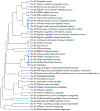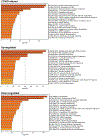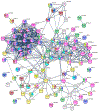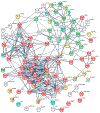An autoantigen profile of human A549 lung cells reveals viral and host etiologic molecular attributes of autoimmunity in COVID-19
- PMID: 33971585
- PMCID: PMC8075847
- DOI: 10.1016/j.jaut.2021.102644
An autoantigen profile of human A549 lung cells reveals viral and host etiologic molecular attributes of autoimmunity in COVID-19
Abstract
We aim to establish a comprehensive COVID-19 autoantigen atlas in order to understand autoimmune diseases caused by SARS-CoV-2 infection. Based on the unique affinity between dermatan sulfate and autoantigens, we identified 348 proteins from human lung A549 cells, of which 198 are known targets of autoantibodies. Comparison with current COVID data identified 291 proteins that are altered at protein or transcript level in SARS-CoV-2 infection, with 191 being known autoantigens. These known and putative autoantigens are significantly associated with viral replication and trafficking processes, including gene expression, ribonucleoprotein biogenesis, mRNA metabolism, translation, vesicle and vesicle-mediated transport, and apoptosis. They are also associated with cytoskeleton, platelet degranulation, IL-12 signaling, and smooth muscle contraction. Host proteins that interact with and that are perturbed by viral proteins are a major source of autoantigens. Orf3 induces the largest number of protein alterations, Orf9 affects the mitochondrial ribosome, and they and E, M, N, and Nsp proteins affect protein localization to membrane, immune responses, and apoptosis. Phosphorylation and ubiquitination alterations by viral infection define major molecular changes in autoantigen origination. This study provides a large list of autoantigens as well as new targets for future investigation, e.g., UBA1, UCHL1, USP7, CDK11A, PRKDC, PLD3, PSAT1, RAB1A, SLC2A1, platelet activating factor acetylhydrolase, and mitochondrial ribosomal proteins. This study illustrates how viral infection can modify host cellular proteins extensively, yield diverse autoantigens, and trigger a myriad of autoimmune sequelae. Our work provides a rich resource for studies into "long COVID" and related autoimmune sequelae.
Keywords: Atlas; Autoantigens; Autoimmunity; COVID-19; Lung; Resource.
Copyright © 2021 The Authors. Published by Elsevier Ltd.. All rights reserved.
Figures







Update of
-
An Autoantigen Profile of Human A549 Lung Cells Reveals Viral and Host Etiologic Molecular Attributes of Autoimmunity in COVID-19.bioRxiv [Preprint]. 2021 Feb 22:2021.02.21.432171. doi: 10.1101/2021.02.21.432171. bioRxiv. 2021. Update in: J Autoimmun. 2021 Jun;120:102644. doi: 10.1016/j.jaut.2021.102644. PMID: 33655248 Free PMC article. Updated. Preprint.
Similar articles
-
An Autoantigen Profile of Human A549 Lung Cells Reveals Viral and Host Etiologic Molecular Attributes of Autoimmunity in COVID-19.bioRxiv [Preprint]. 2021 Feb 22:2021.02.21.432171. doi: 10.1101/2021.02.21.432171. bioRxiv. 2021. Update in: J Autoimmun. 2021 Jun;120:102644. doi: 10.1016/j.jaut.2021.102644. PMID: 33655248 Free PMC article. Updated. Preprint.
-
An Autoantigen Atlas From Human Lung HFL1 Cells Offers Clues to Neurological and Diverse Autoimmune Manifestations of COVID-19.Front Immunol. 2022 Mar 24;13:831849. doi: 10.3389/fimmu.2022.831849. eCollection 2022. Front Immunol. 2022. PMID: 35401574 Free PMC article.
-
An Autoantigen-ome from HS-Sultan B-Lymphoblasts Offers a Molecular Map for Investigating Autoimmune Sequelae of COVID-19.bioRxiv [Preprint]. 2021 Apr 6:2021.04.05.438500. doi: 10.1101/2021.04.05.438500. bioRxiv. 2021. PMID: 33851168 Free PMC article. Updated. Preprint.
-
Molecular/antigenic mimicry and immunological cross-reactivity explains SARS-CoV-2-induced autoimmunity.Autoimmun Rev. 2025 Jun 24;24(7):103811. doi: 10.1016/j.autrev.2025.103811. Epub 2025 Apr 8. Autoimmun Rev. 2025. PMID: 40209971 Review.
-
Autoimmune response after SARS-CoV-2 infection and SARS-CoV-2 vaccines.Autoimmun Rev. 2024 Mar;23(3):103508. doi: 10.1016/j.autrev.2023.103508. Epub 2023 Dec 29. Autoimmun Rev. 2024. PMID: 38160960 Review.
Cited by
-
Paradoxical sex-specific patterns of autoantibody response to SARS-CoV-2 infection.J Transl Med. 2021 Dec 30;19(1):524. doi: 10.1186/s12967-021-03184-8. J Transl Med. 2021. PMID: 34965855 Free PMC article.
-
Integration and Reanalysis of Four RNA-Seq Datasets Including BALF, Nasopharyngeal Swabs, Lung Biopsy, and Mouse Models Reveals Common Immune Features of COVID-19.Immune Netw. 2022 May 19;22(3):e22. doi: 10.4110/in.2022.22.e22. eCollection 2022 Jun. Immune Netw. 2022. PMID: 35799708 Free PMC article.
-
An approach to cellular tropism of SARS-CoV-2 through protein-protein interaction and enrichment analysis.Sci Rep. 2022 Jun 7;12(1):9399. doi: 10.1038/s41598-022-13625-z. Sci Rep. 2022. PMID: 35672403 Free PMC article.
-
Role of E3 ubiquitin ligases and deubiquitinating enzymes in SARS-CoV-2 infection.Front Cell Infect Microbiol. 2023 Jun 9;13:1217383. doi: 10.3389/fcimb.2023.1217383. eCollection 2023. Front Cell Infect Microbiol. 2023. PMID: 37360529 Free PMC article. Review.
-
Post-COVID-19 polyautoimmunity - Fact or coincidence: A case report.Front Med (Lausanne). 2023 Mar 16;10:1013125. doi: 10.3389/fmed.2023.1013125. eCollection 2023. Front Med (Lausanne). 2023. PMID: 37007767 Free PMC article.
References
Publication types
MeSH terms
Substances
Grants and funding
LinkOut - more resources
Full Text Sources
Other Literature Sources
Medical
Research Materials
Miscellaneous

